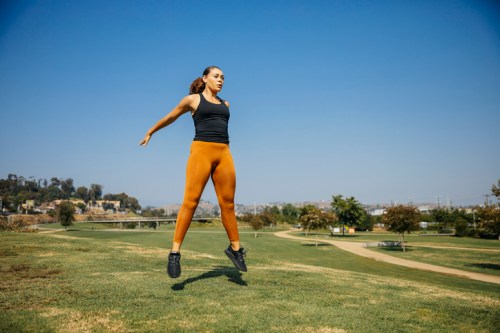A Trainer Tells Us How To Get the Most of the ‘Big 4’ Fitness Moves
A trainer names the most common fitness cues she offers for common moves like squats, single-leg deadlifts, push-ups, and more.

You know those all-time hits that will always have a place on the radio? “I Will Survive,” “Smells Like Teen Spirit,” and “Run the World” are a few that come to mind. Well, in the wonderful world of fitness, there are a few classic strength training moves that will probably always be on heavy rotation. When it comes to making sure you’re giving the hits their due respect (and reaping all the benefits in the process), MIRROR trainer Ashtain Rothchild, NASM, says these are the most common fitness cues she belts out during class that make those moves even more effective.
According to Rothchild, four functional fitness moves always make it into her classes: squats, push-ups, pull-ups, and single-leg deadlifts. (A pretty banger list, right?) “I always like to mention that a workout should be programmed from a place of functionality,” she says. “It isn’t about the ‘crazy moves’ we always see on the Internet, especially social media. You always want to think about keeping your program simple yet effective.” When you keep things simple, you can easily measure your progress over time. For example, maybe you’re able to increase your amount of reps or the weight of your dumbbells.
To make sure you’re reaping the utmost rewards of these fitness moves, we asked Rothchild to break down each move step-by-step. Plus, she gives a refresher course on the top three cues she offers up in her classes. Cue up your playlist and get ready to sweat.
The most common fitness cues trainers give for squats, push-ups, pull-ups, and single-leg deadlifts
1. Squats
“I recommend the squat because it’s one of the functional movement patterns.,” says Rothchild. “This knee dominant exercise will target the lower body while recruiting the core. You can expect to work the quads, glutes, hamstrings, adductors along with the rectus or transverse abdominis obliques and erector spinae.” In other words, every squat is basically a full-body workout. Here are the cues Rothchild gives over and over again:
- 1.As you lower, press your knees out slightly to ensure knee valgus—the knees caving inwards—doesn’t occur.
- 2.Imagine you’re sitting back in a chair. This will help you learn the proper weight distribution so you don’t wind up pouring too much weight into your toes.
- 3.Imagine balancing a book on your head. This will keep your chest lifted.
2. Push-ups
You’re probably not surprised that push-ups made this list. “Nothing beats good old-fashion push-up. They never get easier; you just get stronger. They work the core, pectoralis, deltoids, triceps, and even target the serratus anterior. Push-ups are a great option for targeting the upper body pressing muscles and abs,” says Rothchild. Here’s how to make sure you’re doing ’em right:
- 1.Press your hands into the floor like you’re using a corkscrew. This will help your shoulders and wrists align properly.
- 2.Imagine your squeezing a million-dollar check between your glutes. This will keep you from dipping your hips too low to the ground.
- 3.Think of a push-up like a moving plank. This will encourage you to keep your core engaged.
3. Pull-ups
“[These] are one of the toughest exercises to perform,” says Rothchild, adding that pull-up progressions and full pull-ups will improve your grip strength, strengthen the muscles in your back and core, and work your arms. Ready for your cues?
- 1.If you need assistance, grab a band for banded-assisted pull-ups. Wrap the band around the bar and place your feet on it for the assist.
- 2.Try a negative pull-up: jump up and focus on the slow descent down.
- 3.“If a bar is inaccessible you can always resort to a superman position where you lay on the floor with extended arms and legs, lift arms and legs slightly off the floor, the chin is tucked, pull the elbows down and back to mimic the same movement pattern as a pull-up,” says Rothchild.
4. Single-leg deadlifts
Get ready for Rothchild’s all-time favorite fitness move: the single-leg deadlift. “This hip-dominant exercise challenges your entire posterior chain while also improving your balance and stability,” she says. “You will work your hamstrings, glutes, core, and ankles. This exercise will definitely ensure improved athleticism, especially with walking, running, and jumping.”
- 1.Imagine your hips are like headlights of a car and they’re facing straight down. This will keep you from rolling your hip open.
- 2.Pack your shoulders back and down while you focus on having a long spine. This cue will keep you from rounding your back.
- 3.Drive your heel down into the floor as you come back up to standing. This will activate your hamstrings and glutes.
Oh hi! You look like someone who loves free workouts, discounts for cutting-edge wellness brands, and exclusive Well+Good content. Sign up for Well+, our online community of wellness insiders, and unlock your rewards instantly.
Sign Up for Our Daily Newsletter
Get all the latest in wellness, trends, food, fitness, beauty, and more delivered right to your inbox.
Got it, you've been added to our email list.










